10 Inspiring Stories of Mobile Marketing Growth From the East
Covers brands with eCommerce, Retail, Travel, and OTT Mobile Apps
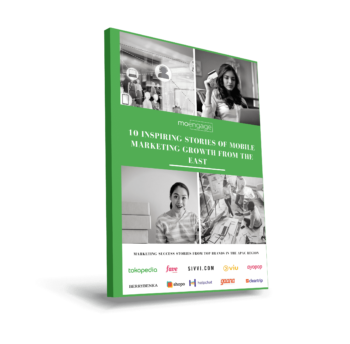
Download an offline copy


1. Overview
In 2014, Google revealed that the Asia Pacific (APAC) region is a mobile-first region. Its consumer barometer research showed the smartphone penetration to be way higher than PC penetration in APAC regions. The adoption of mobile is so widespread that a study by Kantar TNS in 2017, showed that 77% of the APAC consumers made more online purchases using their mobile phones as compared to 61% globally.
There is also a significant difference in mobile-first adoption between the emerging and the developed countries within the APAC region. For instance, Google’s data suggests that emerging countries like Indonesia and India that have lower smartphone penetration than other APAC countries rely more on mobile phones for their daily usage. The earlier study by Kantar TNS also revealed a similar pattern as 93% Indonesians used a mobile phone for making purchases as compared to 22% of Australians.
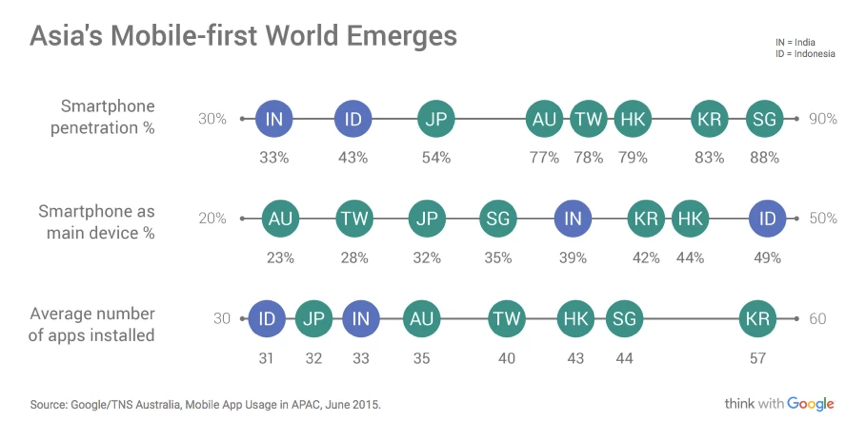
Source: Venture Beat
So, what do these statistics mean to marketers?
APAC is a vast and diverse region On one end of the spectrum lies developed countries like Australia, Singapore, and Hong Kong, while on the other end are emerging countries like India and Indonesia. So, when you plan your next campaign, you have to analyze how consumers from each country shop and build the customer experience accordingly.
1.1. About this eBook
As a leader in the mobile engagement market with presence across Asia, Europe, and the U.S., MoEngage has worked with Fortune 500 companies such as Samsung, Deutsche Telekom, Hearst, Prudential, Vodafone, and Tokopedia. In our interactions with our customers, marketers, and industry experts, we have noticed that marketers face the same challenges across different geographies when it comes to achieving marketing goals. All brands today, aim to deliver a flawless user onboarding experience, engage their mobile app users and bring them back, drive conversions, retain and boost loyal users.
We have, therefore, curated these 10 growth stories from the East that are based on the tenets of a long-term strategy, impeccable execution, and humanized experience in the digital space. These stories will help you understand what it takes to cater to a mobile-first region, and how you can leverage it to drive sales. We have divided these stories into four sections based on your marketing funnel i.e. Onboarding, Engagement, Conversions, and Retention.
2. Onboarding
Getting a consumer to install an mobile app can be an uphill task for marketers. A study by Liftoff, a mobile mobile app marketing and retargeting company, reveals that the average cost to get a customer install a mobile app can cost up to $4.12. And it does not end there. Considering the heavy competition in the mobile mobile app ecosystem, marketers have to constantly ensure that they remain on top of their customers’ minds. You have to spend money to ensure that users download, log in and use the mobile app. The challenge here is that you will not be able to showcase the ROI immediately. You might have to spend anywhere up to $8.21 to get a first-time user to create an account on your mobile app. Your users will take some time to understand the mobile app and trust it enough to complete a transaction. Remember, the first month is the most crucial time to onboard and get the user accustomed to your mobile app. So, you must have a well-planned digital marketing strategy to onboard new customers. Winning customer trust is very important in this phase.
Take a look at how companies like Tokopedia and Shopo onboard new users in a successful manner.
2.1. How Tokopedia Grew New User Retention by 60%
Tokopedia, Indonesia’s largest online marketplace was facing challenges while onboarding new customers. 60% of customers that installed Tokopedia’s mobile app, uninstalled it within the first month.

Tokopedia realized the need to create 1:1 personalized experiences for new mobile app users in order to engage and encourage them to complete the first purchase.
They identified the various stages in the customer’s onboarding journey where they could send the right messages to eliminate ambiguity in communication. They leveraged MoEngage Flows to create a series of integrated cross-channel campaigns and targeted users through various channels including push notifications, emails, SMS, and retargeting with personalized messages.
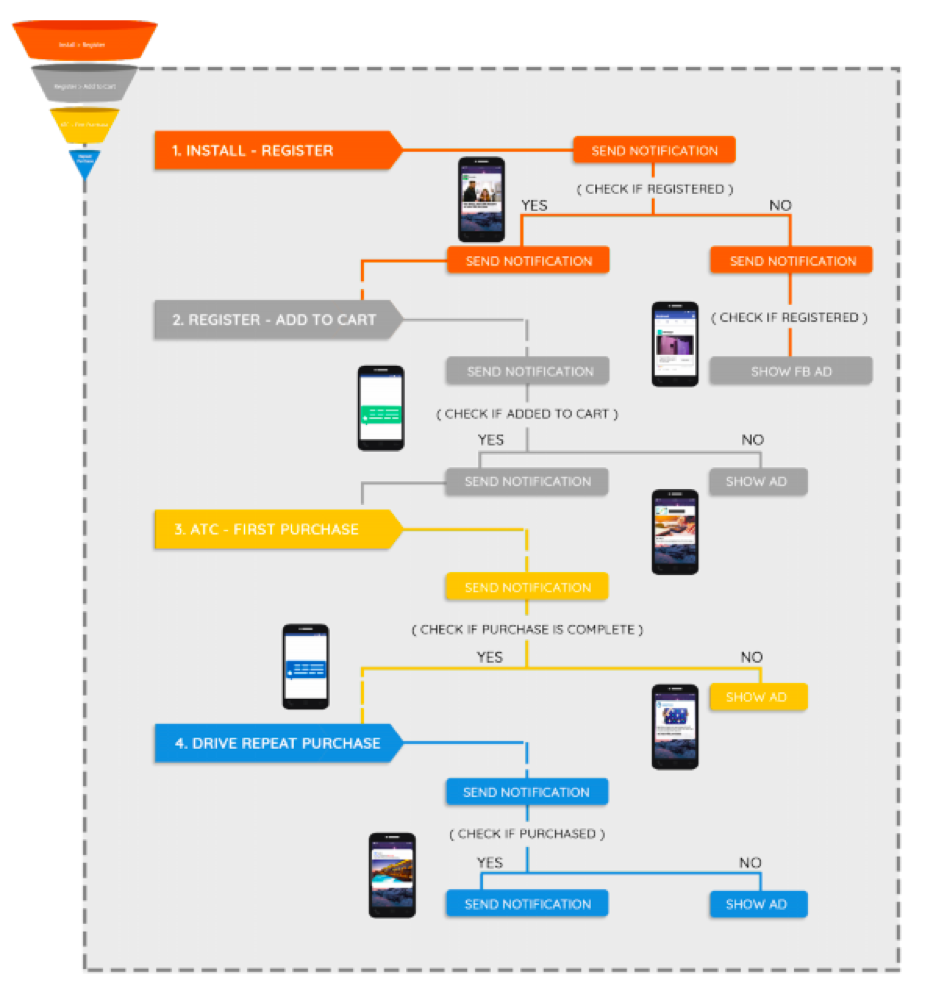
This personalized mobile approach helped Tokopedia improve their first-month mobile app user retention by 60% and boost their first-purchase rate by 20%.
Want to find out more? Take a look at this case study.
2.2. Shopo’s “Always be Onboarding” Strategy to Lower First Week User Drop-offs
Shopo, C2C (Customer to Customer) Marketplace from Snapdeal (an e-commerce portal in India) also did something similar to onboard users to their mobile app. C2C was a relatively new concept in India, and users needed guidance to set up stores, enable payment gateways, sell or purchase, etc. Given the tendency to drop-off after one visit, Shopo adopted an ‘always be on-boarding’ mobile approach. They sent relevant push notifications to the users and helped them get accustomed to the mobile app. Shopo used MoEngage’s Smart Trigger Push Messages to send perfectly timed notifications to the users at regular intervals. Shopo also used MoEngage’s Smart Triggers to track user events on the mobile app and guide users to pick up right from where they left. This helped Shopo bring users back to the mobile app.
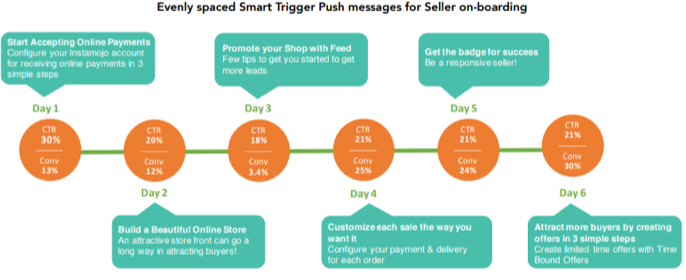
It also helped them reduce the drop-offs during the first week and led to an increase in conversions by 13%.
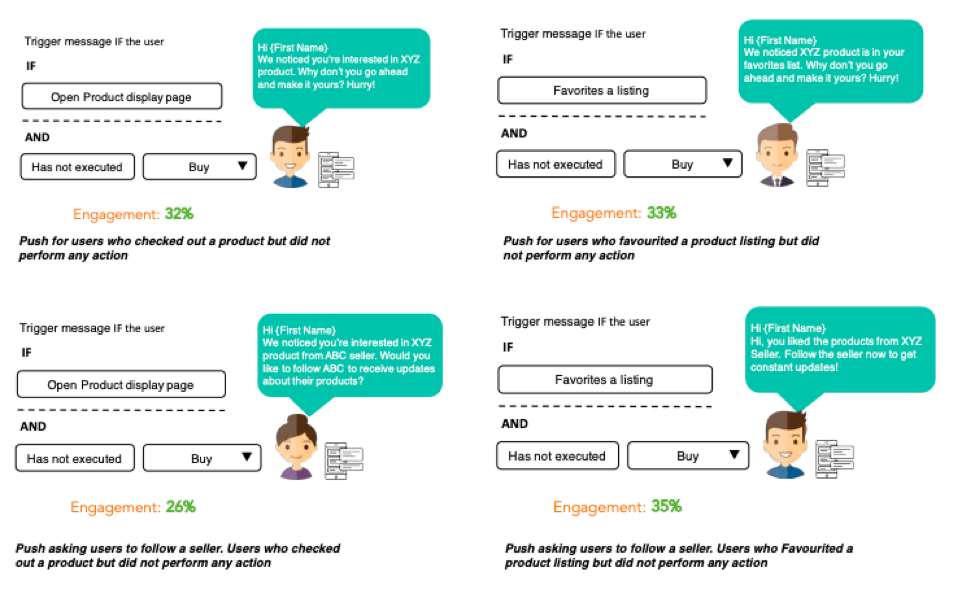
3. Engagement
While onboarding users and leading them to use your mobile app is half the battle won, marketers should work further to keep the momentum going and ensure that the users are continuously engaged. In a survey conducted for mobile marketers, over 55% respondents said that user engagement to be their biggest challenge.
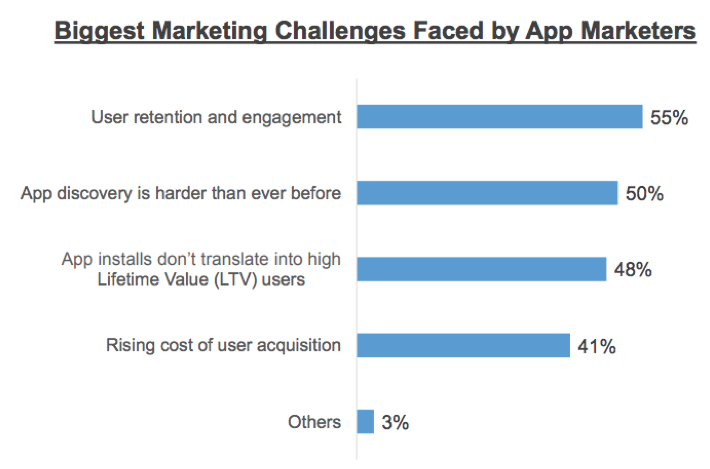
Source: Business of mobile apps
According to another report by mobile app Annie, smartphone users use 9 mobile apps every day and 30 per month. Which means that capturing the user’s attention can be a challenge. With reduced attention spans and so many mobile app options available, mobile app marketers need to think of innovative ways to engage with their users at all times. Here are 3 such inspiring stories from Viu, BerryBenka, and Helpchat that throw the spotlight on out-of-the-box strategies to stay with your users every step of the way.
3.1. Viu’s Personalized Engagement Elevates Reach by 300%
Viu is a leading over-the-top video service provider in emerging markets such as India, Indonesia, Egypt, UAE, Saudi Arabia, and Malaysia. Viu wanted to engage more and more mobile app users in order to boost video viewership and reduce churn. They used MoEngage’s Dynamic Content Recommendation that armed the brand with AI-driven video recommendations tailored for their mobile app users. Highly personalized messages sent at the right time motivated Viu’s users to return to the mobile app and helped the brand boost their overall engagement rate. Viu saw a 53% increase in video viewership from targeted video recommendations.
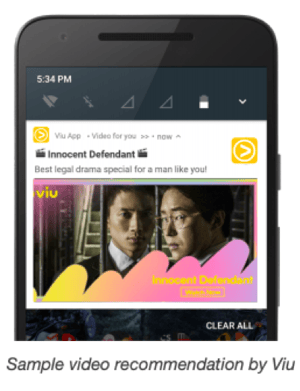
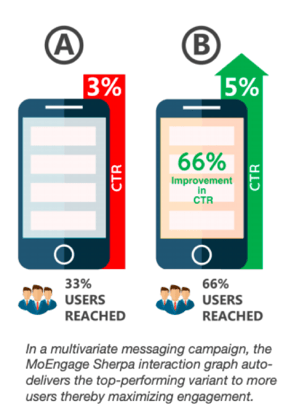
More often that not, mobile app marketers face challenges in reaching users using OEMs such as OnePlus, Gionee, Xiaomi, Micromax, and Vivo. The device and network limitations can cut off Google Push Delivery – an essential cord to deliver push notifications. Viu used MoEngage’s Push Amplification that acted as a fall back to Google Push Delivery to deliver the notifications. This improved the delivery rate from 6.20% to 24.50% – a 300% improvement in terms of delivery and reach for the brand!
There’s more. You can read the case study and find out how Viu continues to engage it’s mobile app users with the help of marketing automation.
3.2. Moving Away From “Batch and Blast” Campaigns, BerryBenka Grows Engagement by 14%
BerryBenka, an Indonesia-based online fashion, and beauty store wanted to create a seamless customer experience across different channels in order to maximize user engagement.
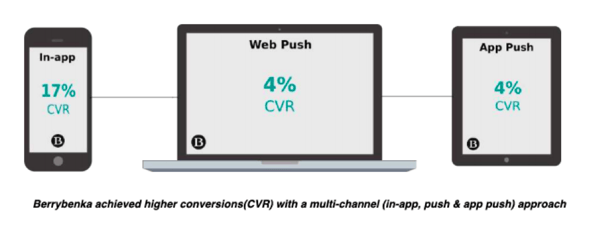
They used MoEngage’s Deep-dive Analytics to deliver segmented campaigns to their mobile app users based on the user’s activity. The segmented data helped their marketing team implement a personalized engagement strategy.

The brand shifted focus from batch-and-blast campaign to personalization and was able to improve their user engagement rate by 14%. They also leveraged MoEngage’s Smart Triggers to optimize the content, timing, and delivery of the push notifications, which improved the CTR by 10% of which 4% users completed a purchase on their mobile app.
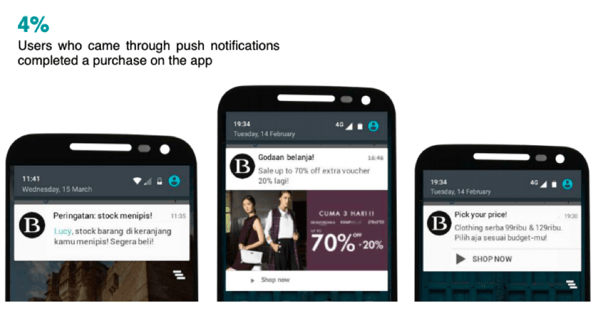
To ensure that their web users are not left behind, they also used MoEngage’s Web Push Notifications to engage, retain, and convert 4% of the visitors into customers.
Read Berrybenka’s success story to know more.
3.3. How Helpchat Used Email Marketing to Re-engage 17% Inactive App Users
If you thought email marketing was dead, think again. With over 4.9 billion active email accounts (more than the 2.23 billion active users of Facebook), email is undeniably an effective method to reach more users. It gives you the power to segment your users and track the progress of your campaigns efficiently. If you are still unsure about how effective email marketing is, take a look at how Helpchat, an AI-powered personalized transactions platform improved its open rates up to 34% for its email campaigns and re-engaged 17% of its inactive users on the mobile app.
Helpchat used MoEngage’s Email capabilities to introduce new users to the features available in their mobile app. To re-engage their inactive users, Helpchat segmented their email campaigns and crafted their content and push notifications to drive users back to the mobile app.

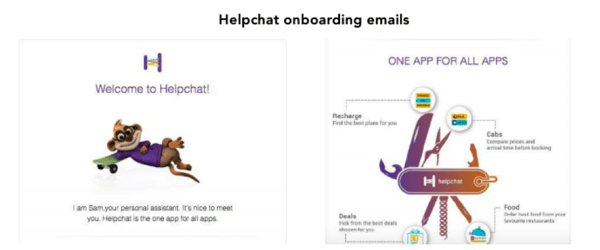
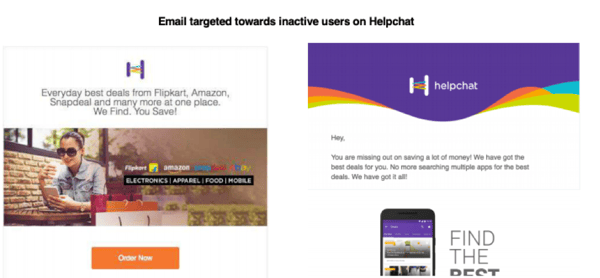
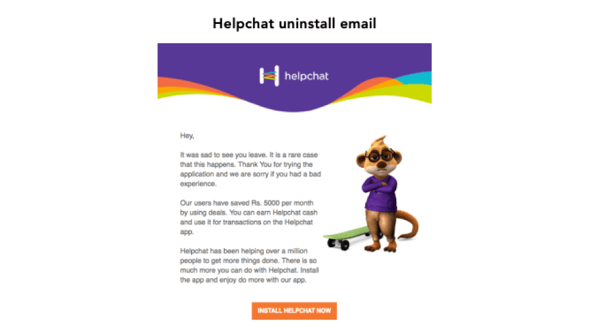
This helped the brand improve their re-engagement rate by 17%. Using MoEngage’s Uninstall Tracking and Analytics, Helpchat was implement email campaigns to reconnect with users who had uninstalled their app to gather feedback about their mobile app. This helped Helpchat improve their engagement rate by 34%.
You can read the case study to know more.
4. Conversions
Your users may have downloaded the mobile app and even engaged with your content by clicking on the notification or by opening the email. However, the real revenue comes from the in-mobile app purchases done by the customer. The survey by Liftoff shows that marketers should spend a minimum of $64.96 per user to nudge them to purchase via a mobile app. Therefore, it is essential for marketers to tailor their products and offers to suit the specific needs and interests of every user. Here are a few examples of how companies like Ayopop, Sivvi, and Cleartrip improved their sales through personalized offerings.
4.1. AI-powered Marketing Helped Ayopop Increase Transaction Rate by 50%
Ayopop is Indonesia’s mobile bill payment platform. ayopop found that 60% of their users were not completing the transactions. They wanted to increase the number of active users, identify cart abandonment and reduce it, and re-engage the users on the platform. To meet these three business objectives, Ayopop used MoEngage’s Sherpa to personalize push notifications sent to users belonging to three segments – cart abandonment, cross-sell, and product reminders.

Ayopop sent personalized push notifications to the users who did not complete a transaction within two hours of drop-off.
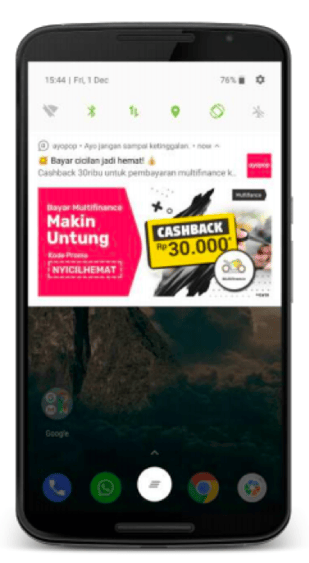
They also offered recommendations of similar products to help the user make an informed decision. This helped Ayopop lower cart abandonment up to 55%. Similarly, MoEngage Sherpa helped the brand cross-sell products for sustained engagement, which increased their in-app transaction rate by 50%.
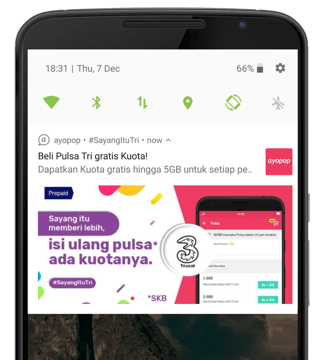
Subscription reminders to users nearing the end of their subscription led to 200% rise in transactions.
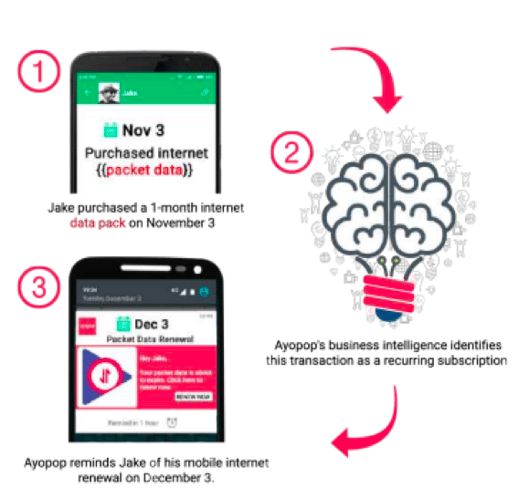
Read more about Ayopop’s challenges and use cases here.
4.2. Fashioning Personalized Campaigns to Help Sivvi Recover 16% Users Who Had Abandoned Carts
Sivvi, a Dubai-based online fashion retailer for clothes, footwear, and accessories for men and women experienced low conversions due to cart abandonment. While they used traditional re-targeting channels to improve conversions, they realized they needed to look for more cost-effective methods to improve conversions. They used MoEngage’s Dynamic Email Retargeting and MoEngage’s Smart Triggers to lower cart abandonment and improve their conversion rate. Sivvi sent personalized emails to their users reminding them of the products saved in the cart.
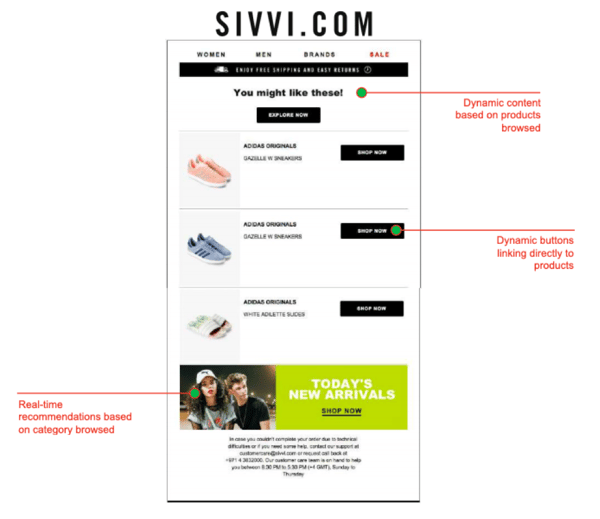
Similarly, they used MoEngage’s Smart Triggers to send push notifications to users who abandoned their carts. These personalized notifications helped Sivvi recover 16% of the abandoned users and drive their sales.
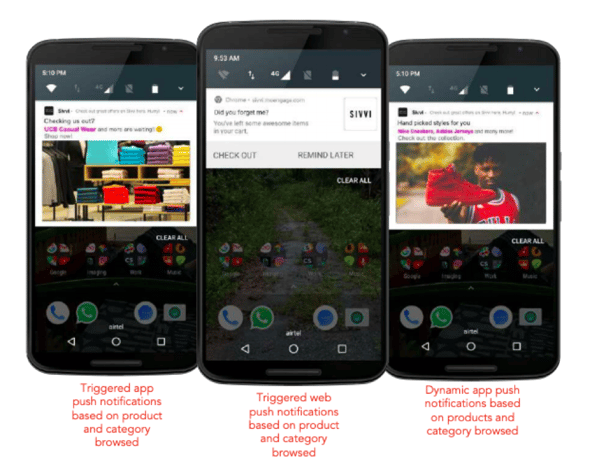
Find out how Sivvi achieved their marketing goals to drive user engagement and conversions in this case study.
4.3. How Cleartrip Increased In-app Reservations by 19%
Most consumers travel less than 3-4 times a year. One of the biggest challenges for travel and hospitality mobile app marketers is that the frequency at which users returned to the mobile app is lower when compared with other mobile apps like ecommerce and OTTs. However, the good part is when users log in to their mobile app, they usually have a high purchase intent. Travel and hospitality brands should be present in their users’ micro-moments and convert a visit into a sale. Here’s how Cleartrip, a India-based online travel company used MoEngage’s Push Notifications to onboard, activate, and engage the customer. Cleartrip showed personalized in-app messages to customers who installed the mobile app through different acquisition campaigns.
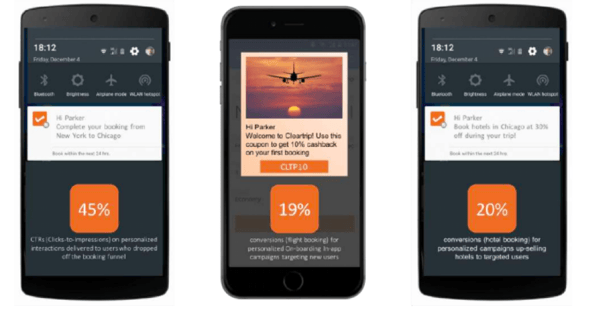
This led to a 19% increase in conversions. For those who installed the mobile app but did not make reservations, Cleartrip triggered personalized push notifications driving them to complete the purchase. To engage with users who abandoned their carts, Cleartrip sent personalized smart triggers that reminded the users about the pending reservations that helped them drive 16% conversions. Cleartrip further personalized the experience by sending personalized hotel deals that resulted in 20% of users booking the recommended hotel rooms.
5. Retention
According to a study by MoEngage, 71% of the mobile app users churn within 90 days. In most cases, users do not engage with the mobile app beyond once in a month. There could be multiple reasons for this abysmal churn rate ranging from lack of engagement with the user to lack of in-mobile app guidance.
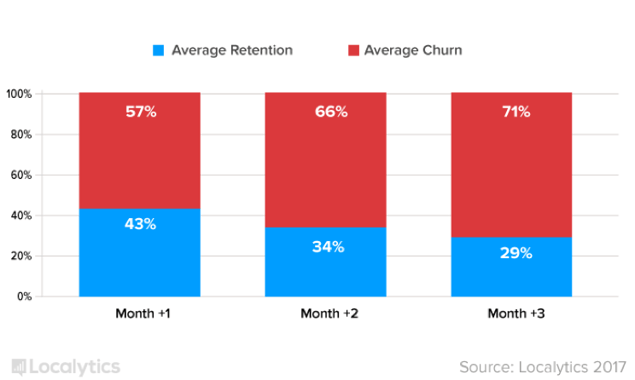
Retaining a user is as big a challenge for marketers as engaging them. We bring two stories of Gaana.com and Fave.com to demonstrate how these brands have retained their customers through continuous and valuable engagement.
5.1. Gaana.com Grows Premium Music Subscriptions by 120%
Music is a personal choice. Mobile app marketers, therefore, have to find new ways to build 1:1 engagement with their users. Unfortunately, most companies are unable to implement personalization at scale. Here’s how gaana.com implemented a 1:1 engagement strategy to reduce their mobile app user churn rate. Gaana is a leading music streaming service in India. They wanted new customers to subscribe to Gaana+, their premium account and return to listen to music. Gaana used MoEngage’s Push Notifications to create lifecycle campaigns.
After a 14-day free trial to the Gaana+ account, Gaana sent personalized reminder messages to users highlighting the benefits of the premium account. This helped Gaana increase their premium subscriptions by 120%.

Gaana created user segments based on languages, region, genre, and play history. They implemented engagement campaigns on these segments to drive large-scale personalization. They also leveraged rich-personalized carousel notifications, which resulted in 10% Daily Active Users on the mobile app.
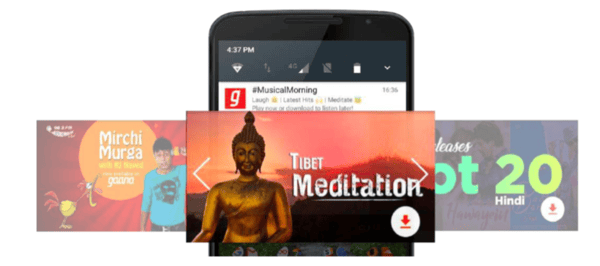
Read more about Gaana’s success story here.
5.2. Fave Grows Customer LTV by 2X
Fave is one of the fastest growing fitness platforms in South-east Asia. Fave wanted to increase customer LTV (Life Time Value) by encouraging users to make repeat purchase on the mobile app. Fave used MoEngage Flows to create, visualize, and deploy multiple, interconnected campaigns across channels. Fave automated user on-boarding and re-engagement flows to guide their new and existing users to the next stage in their customer‘s lifecycle journey.
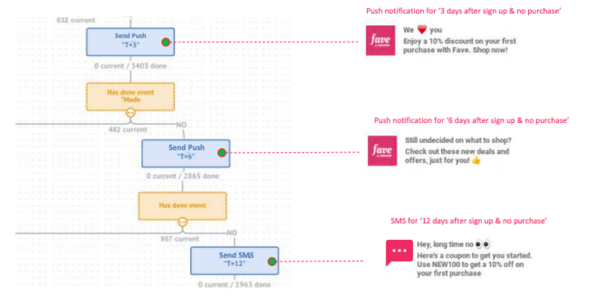
From sending SMSes and push notifications to new users to sending updates about new arrivals and guiding them to utilize Fave wallet for payments, the workflow helped Fave increase their purchase transactions by 15% and grow the customer LTV by 2X.
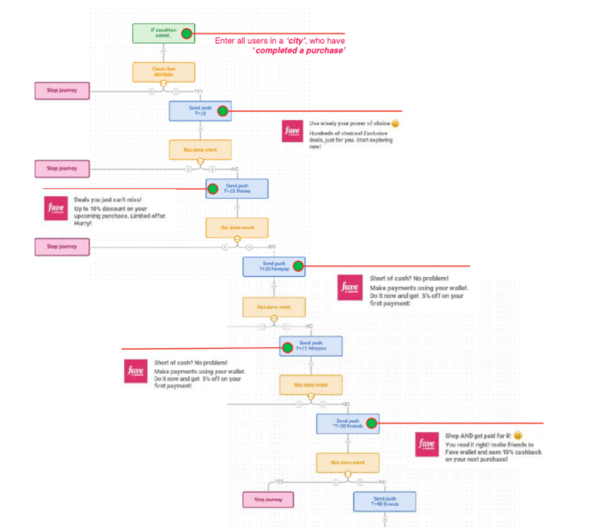
You can read the full case study for more details.
6. About MoEngage
MoEngage is an intelligent marketing cloud, built for the mobile-first world. With AI-powered automation and optimization capabilities, MoEngage enables hyper-personalization at scale across multiple channels like mobile push, email, in-mobile app, web push, and SMS. Fortune 500 brands across 35+ countries such as McAfee, Samsung, and Vodafone use MoEngage to orchestrate their omnichannel campaigns. MoEngage has been featured on Gartner’s Magic Quadrant and is the youngest company on the list.
To talk to an expert about customer engagement and conversions in retail, write to us at [email protected].
